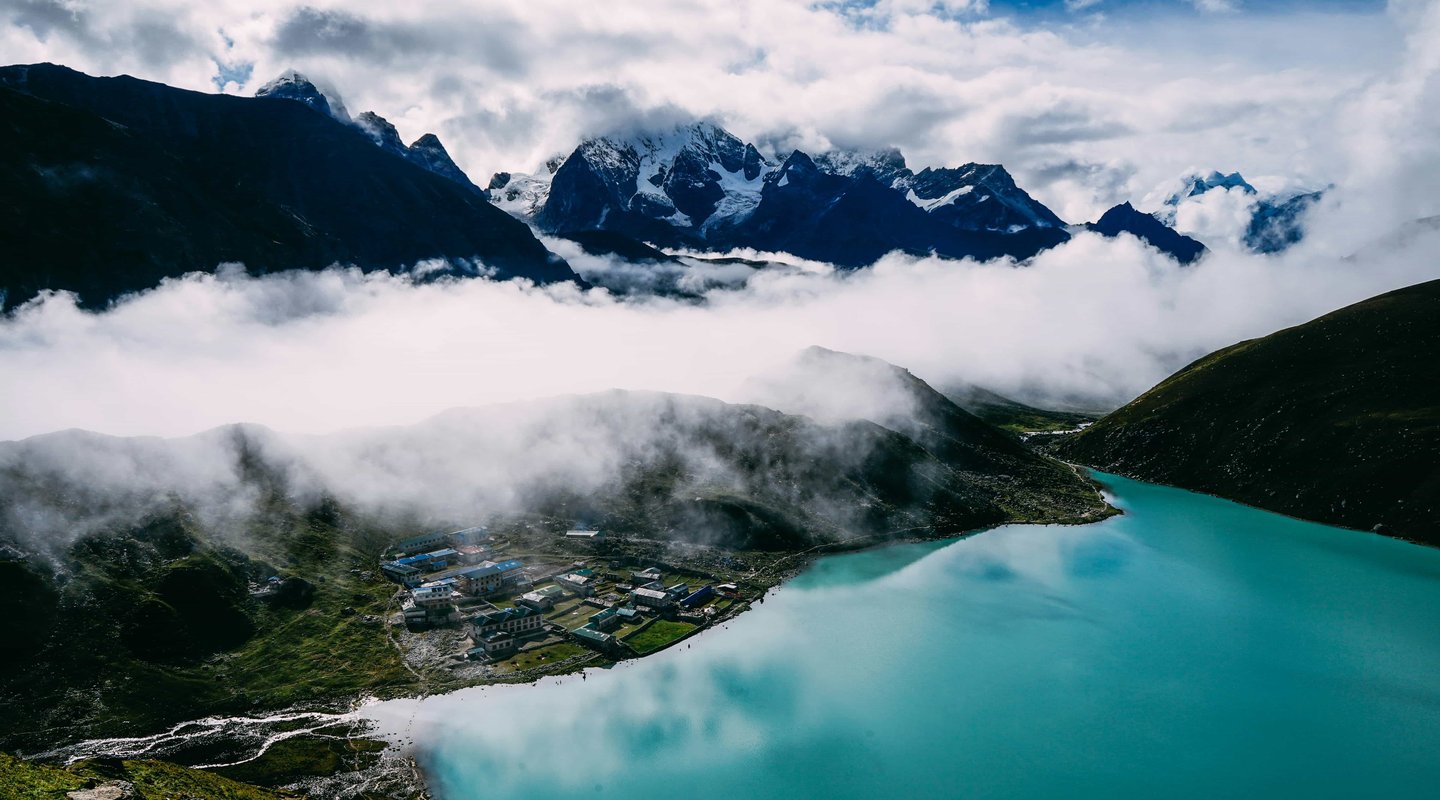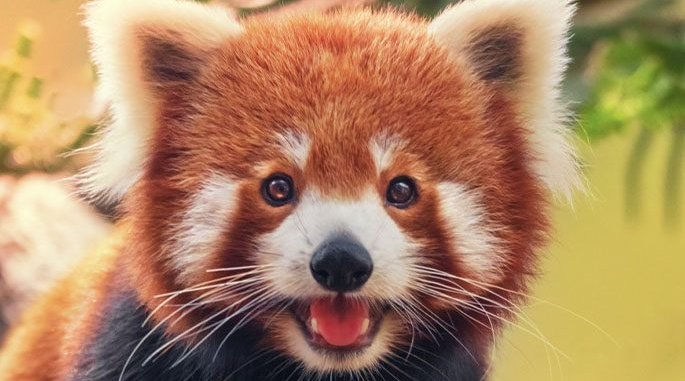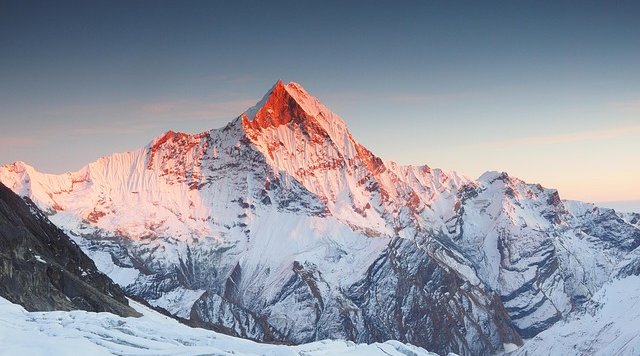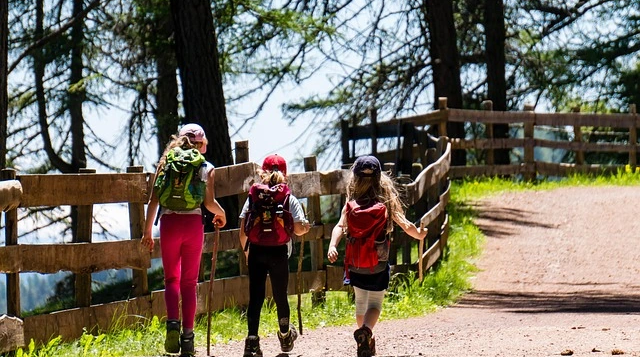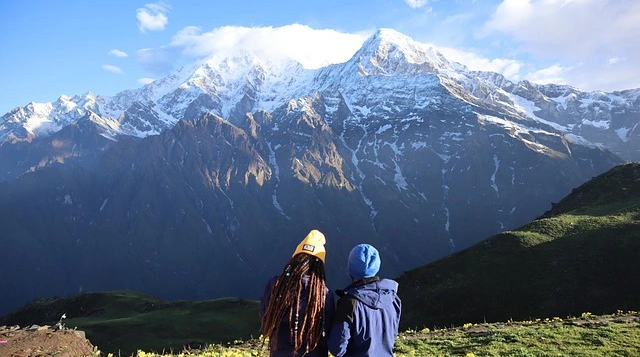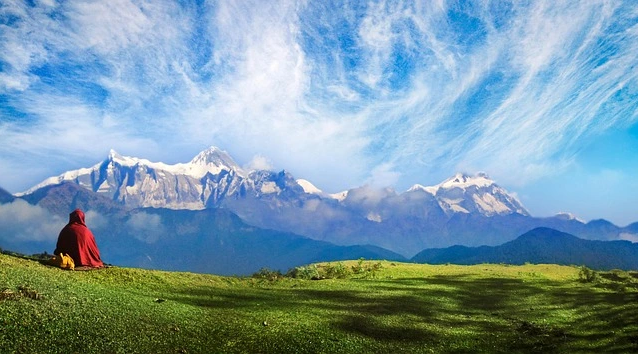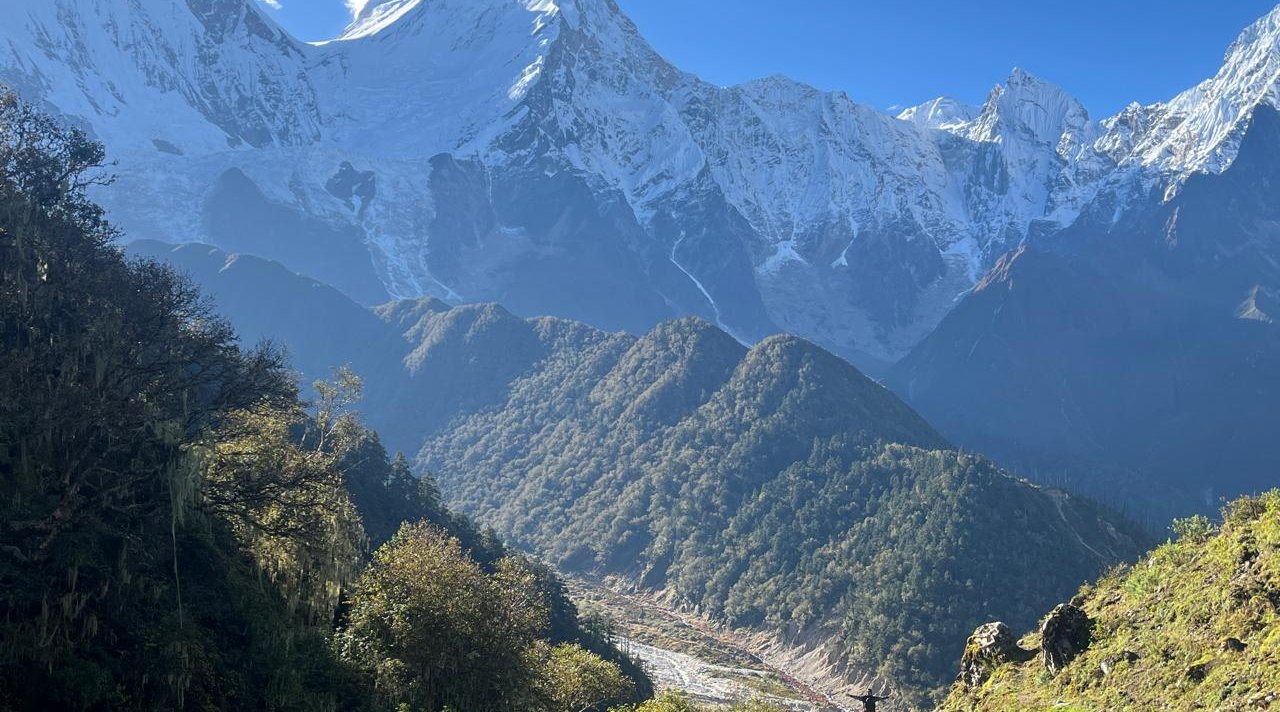Planning your dream trek to the pristine turquoise waters of Gokyo Lakes? This comprehensive guide reveals exactly how much does Gokyo Lakes trek cost and provides the perfect Gokyo Lake trek itinerary for 2026.
What Makes the Gokyo Lakes Trek Special?
The Gokyo Lakes trek offers an extraordinary alternative to the crowded Everest Base Camp route. You'll trek through ancient Sherpa villages adorned with colorful prayer flags and past Buddhist monasteries echoing with morning chants.
The trail follows the serene Dudh Koshi valley alongside the massive Ngozumpa Glacier. Unlike the main Everest trail, you'll encounter yak herders and experience authentic mountain life without the crowds.
Standing atop Gokyo Ri viewpoint at 5,357 meters rewards you with dawn breaking over four 8,000m peaks. Below, six emerald lakes reflect Everest, Lhotse, Makalu, and Cho Oyu in their pristine waters.
Complete Gokyo Lake Trek Cost Breakdown for 2026
Understanding expenses helps you plan whether you're considering a budget vs luxury Gokyo trek. Let's break down every cost you'll encounter on this remarkable Sagarmatha region journey.
Essential Permits and Documentation
Every trekker needs these mandatory permits:
- Sagarmatha National Park permit: NPR 3,000 ($25 USD)
- TIMS card (Trekkers' Information Management System): NPR 2,000 ($17 USD)
- Checked at Monjo and Namche Bazaar checkpoints
Most agencies like HimalayanHero include permit costs in packages. They handle all paperwork, saving you valuable time in Kathmandu.
Professional Guide and Porter Services
The Gokyo Lakes trek guide cost varies by experience level:
- Licensed guide: $25-35 per day
- Porter service: $15-20 per day (carries 20kg)
- Guide-porter combo: $20-25 per day
Your guide monitors altitude sickness symptoms and shares Sherpa culture insights. They explain the significance of mani stones, chortens, and prayer wheels you'll encounter daily.
Choose agencies following responsible trekking practices that provide staff insurance and proper equipment. Fair employment ensures better service and supports local communities.
Accommodation Along the Trail
Teahouse lodging costs increase with altitude:
Lower Elevations (Phakding, Namche):
- Room cost: $3-5 per night
- Twin beds with thick blankets
- Shared bathroom facilities
Mid-Elevations (Dole, Machhermo):
- Room cost: $5-8 per night
- Basic amenities
- Limited hot water availability
Higher Elevations (Gokyo):
- Room cost: $8-10 per night
- Essential facilities only
- Bring -15°C rated sleeping bag
Peak season requires advance booking through agencies. Some lodges now offer attached bathrooms for luxury Gokyo Lake trek itinerary options.
Food and Beverage Costs
Nepali meals offer the best value with unlimited refills:
- Dal bhat (rice, lentils, vegetables): $5-8
- Morning porridge or eggs: $4-8
- Western dishes (pasta, pizza): $7-12
Hot drinks become essential at altitude:
- Tea/coffee: $2-5 per cup
- Ginger lemon honey (aids acclimatization): $3-4
- Hot chocolate: $4-5
Bottled water prices escalate dramatically:
- Lukla: $1 per liter
- Namche: $2-3 per liter
- Gokyo: $4 per liter
Consider water purification tablets or filters for economy and environmental responsibility.
Transportation Costs
The adventure begins with the famous Lukla flight:
- Kathmandu-Lukla: $217 (foreigners, includes taxes)
- Ramechhap-Lukla (peak season alternative): $175
- Jeep to Ramechhap: $25-30
Weather delays are common—budget extra nights accordingly. Helicopter options cost $500-600 per person to Lukla or $1,800 for Gokyo-Kathmandu returns.
Hidden Costs That Add Up
These often-overlooked expenses impact your budget:
Comfort amenities:
- Hot showers: $3-5 each
- Wi-Fi access: $3-5 per hour
- Device charging: $2-4 per item
Essential extras:
- Power banks (bring 2-3): $30-50 investment
- Snacks and chocolate bars: $2-5 each
- Souvenirs from villages: $10-50
Mandatory expenses:
- Travel insurance (up to 6,000m): $100-200
- Guide/porter tips: 10-15% of total fee
- Emergency fund: $200-300 recommended
Budget vs Luxury Options
Budget Trek ($800-1,000):
- Basic teahouses only
- Self-guided or minimal support
- Standard meals
- Shared facilities throughout
Standard Trek ($1,200-1,500):
- Comfortable accommodations
- Professional guide and porter
- Meal variety
- Some private bathrooms
Luxury Trek ($2,500-4,000):
- Best available lodges
- Senior guides with extensive experience
- Premium meal options
- Helicopter return possible
Best Value: HimalayanHero's 14-day package at $1,235 includes everything essential with excellent safety standards.
Detailed Gokyo Lake Trek Itinerary Options
The Complete 14-Day HimalayanHero Adventure
This itinerary balances proper acclimatization with comprehensive exploration. Perfect for first time Gokyo Lake trek difficulty concerns.
Day 1: Fly to Lukla, Trek to Phakding
- Altitude: 2,840m to 2,610m
- Duration: 3-4 hours walking
- Highlights: Thrilling mountain flight, gentle riverside trail
Day 2: Trek to Namche Bazaar
- Altitude gain: 830m (to 3,440m)
- Duration: 6-7 hours
- Challenges: Steep final climb, multiple suspension bridges
Day 3: Acclimatization in Namche
- Activities: Visit Sherpa Museum, explore Saturday market
- Options: Hike to Everest View Hotel
- Preparation: Last chance for gear shopping
Day 4: Namche to Dole
- Altitude: 3,440m to 4,090m
- Duration: 5-6 hours
- Views: Ama Dablam, Everest, Lhotse panoramas
Day 5: Dole to Machhermo
- Altitude gain: 380m (to 4,470m)
- Duration: 4-5 hours
- Wildlife: Possible Himalayan tahr, danphe sightings
Day 6: Rest Day in Machhermo
- Acclimatization hikes to nearby ridges
- Learn about 1974 Yeti legend
- Practice altitude breathing techniques
Day 7: Reach Gokyo Lakes
- Final altitude: 4,790m
- Duration: 4-5 hours
- Highlight: First glimpse of turquoise lakes
Day 8: Gokyo Ri Sunrise Summit
- Gokyo Ri sunrise hike starts 4 AM
- Summit elevation: 5,357m
- Views: Four 8,000m peaks panorama
Day 9: Explore Upper Lakes
- Visit fifth and sixth lakes
- Duration: 5-6 hours round trip
- Experience: Complete solitude, pristine beauty
Days 10-12: Descent to Lukla
- Retrace route with new perspectives
- Celebrate in Namche
- Final night festivities in Lukla
Days 13-14: Return to Kathmandu
- Morning flight (weather permitting)
- Buffer day for delays
Alternative Itinerary Options
Gokyo Lake Trek 10 Days Itinerary:
- Suits experienced, fit trekkers
- Skips upper lakes exploration
- Higher altitude sickness risk
- Cost: $800-1,000
Gokyo Lake Trek 12 Days Itinerary Cost:
- Balances time and acclimatization
- Includes Gokyo Ri summit
- One acclimatization day
- Cost: $1,000-1,400
Extended 18-Day with Cho La Pass:
- Combines Everest Base Camp trek
- Crosses challenging 5,420m pass
- Everest Base Camp and Gokyo Lakes trek cost: $1,800-2,500
- Requires crampons and experience
For ultimate adventure, consider the Everest Three Passes Trek including Renjo La Pass and Kongma La.
Essential Practical Information
Trek Difficulty for First-Timers
The first time Gokyo Lake trek difficulty rates moderate to challenging. Key factors include:
Physical Requirements:
- Walk 5-7 hours daily
- Handle steep ascents/descents
- Carry 5-8kg daypack
- Previous hiking experience helpful
Altitude Challenges:
- Gradual acclimatization essential
- Symptoms monitoring crucial
- Slower pace above 3,500m
- Diamox consideration (consult doctor)
Mental Preparation:
- Basic accommodation acceptance
- Weather variability tolerance
- Patience with delays
- Positive attitude essential
Best Time to Trek Gokyo Lake
Spring Season (March-May):
- Clear mountain views guaranteed
- Rhododendron forests blooming
- Stable weather patterns
- Peak season crowds
Autumn Season (September-November):
- Best visibility conditions
- Comfortable temperatures
- Festival celebrations in villages
- Advance booking essential
Winter Trekking (December-February):
- Crystal-clear mountain views
- Minimal crowds on trails
- Extreme cold (-15°C nights)
- Some teahouses may close
Monsoon Season (June-August):
- Lukla flight disruptions common
- Lush green valleys
- Limited mountain views
- Lowest prices available
Complete Packing List Essentials
Clothing Layers:
- Merino wool base layers (2 sets)
- Insulated down jacket (-15°C rated)
- Waterproof shell jacket/pants
- Trekking pants (3 pairs)
- Fleece jacket for mid-layer
Head to Toe Gear:
- Sun hat with neck protection
- Warm beanie for evenings
- Buff or neck warmer
- UV protection sunglasses
- Liner and insulated gloves
Essential Equipment:
- Sleeping bag (-15°C minimum)
- Trekking poles (knee savers)
- Headlamp plus spare batteries
- Daypack (25-35 liters)
- Duffel bag for porters
Personal Care Items:
- Sunscreen SPF 50+
- Lip balm with SPF
- Personal first-aid kit
- Water purification tablets
- Wet wipes and hand sanitizer
Electronics:
- Power banks (minimum 2x 20,000mAh)
- Camera with extra batteries
- Universal adapter
- Waterproof phone case
Altitude Sickness Prevention
Successful acclimatization requires discipline and awareness:
Golden Rules:
- Climb high, sleep low principle
- Maximum 500m elevation gain/day above 3,000m
- Drink 3-4 liters water daily
- Avoid alcohol completely
Warning Signs to Monitor:
- Persistent headaches
- Nausea or vomiting
- Extreme fatigue
- Difficulty sleeping
- Loss of appetite
Prevention Strategies:
- Include rest days (Namche, Machhermo)
- Consider Diamox (125mg twice daily)
- Maintain steady pace
- Communicate symptoms immediately
Emergency Protocols:
- Immediate descent for severe symptoms
- Portable oxygen availability
- Helicopter evacuation insurance mandatory
- Guide trained in altitude illness
Travel Insurance Requirements
Comprehensive coverage must include:
- High-altitude trekking (up to 6,000m)
- Emergency helicopter evacuation
- Medical treatment in Nepal
- Trip cancellation protection
- Flight delay compensation
Average cost: $100-200 for two weeks. Check HimalayanHero's recommended insurers.
Trek Comparisons and Alternatives
Gokyo Trek vs Everest Trek Comparison
Making the Gokyo trek vs Everest trek comparison helps choose your ideal adventure:
Gokyo Lakes Advantages:
- Superior Everest views from Gokyo Ri
- Pristine turquoise lakes scenery
- Significantly fewer crowds
- More gradual altitude gain
- Authentic cultural experiences
Everest Base Camp Advantages:
- Iconic destination achievement
- Khumbu Icefall experience
- Better infrastructure/facilities
- More flight options
- Greater teahouse variety
Viewpoint Comparison: Gokyo Ri vs Kala Patthar
Gokyo Ri (5,357m) Features:
- 360-degree mountain panorama
- Four 8,000m peaks visible
- Turquoise lakes below
- Less crowded sunrise
- Longer, gradual ascent
Kala Patthar (5,545m) Features:
- Closest Everest views
- Higher elevation bragging rights
- Steeper, shorter climb
- Often overcrowded
- Rocky, exposed summit
Combination Trek Options
Gokyo + EBC via Cho La Pass:
- 18-20 days duration
- Technical pass crossing
- Complete Everest region experience
- Cost: $1,800-2,500
- Requires excellent fitness
Three Passes Trek:
- Ultimate 21-day adventure
- Crosses Renjo La, Cho La, Kongma La
- Combines all major highlights
- Expert guide essential
- Budget: $2,200-3,000
Explore all Everest region options for detailed comparisons.
Why Choose HimalayanHero for Your Gokyo Adventure
Unbeatable $1,235 Package Value
The HimalayanHero Gokyo Lakes trek includes:
Professional Support:
- Licensed, experienced guides
- Strong, insured porters
- 1:2 porter-trekker ratio
- 24/7 Kathmandu office support
Complete Logistics:
- Round-trip Lukla flights
- All permits handled
- 13 nights accommodation
- Three daily meals
Safety Equipment:
- Comprehensive first-aid kit
- Pulse oximeter monitoring
- Emergency oxygen available
- Satellite phone communication
Local Expertise and Commitment
With 15+ years in the Everest region, HimalayanHero prioritizes:
Sustainable Tourism:
- Fair porter wages
- Environmental protection initiatives
- Local community support
- Small group sizes (max 12)
Safety Standards:
- Wilderness first-aid certified guides
- Twice-daily health checks
- Flexible itinerary adjustments
- Emergency evacuation protocols
Cultural Immersion:
- Sherpa guide knowledge sharing
- Monastery visit arrangements
- Traditional meal experiences
- Village interaction opportunities
Booking Your Trek
Ready to book Gokyo Lakes trek Nepal? Here's how:
- Check availability on HimalayanHero.com
- Secure dates with 20% deposit
- Receive detailed preparation guide
- Join pre-trek briefing in Kathmandu
- Begin your adventure fully prepared
Frequently Asked Questions
Is Gokyo Lakes Trek Suitable for Beginners?
Yes, with proper preparation. The trek requires moderate fitness but no technical climbing skills. Train 3-4 months in advance with regular hiking and cardio exercises.
Can I Do Gokyo Trek Without a Guide?
While legally possible, hiring a guide significantly enhances safety and experience. Solo trekkers often struggle with altitude issues and route finding above Namche.
What's the Success Rate for Reaching Gokyo Ri?
With proper acclimatization, 85-90% of trekkers successfully summit Gokyo Ri. The HimalayanHero itinerary includes strategic rest days maximizing success rates.
How Cold Does It Get at Gokyo?
Night temperatures range from -5°C (autumn/spring) to -15°C (winter). Proper sleeping bags and clothing layers are essential for comfort.
Is Gokyo Trek Less Crowded Than EBC?
Absolutely. Gokyo sees 60-70% fewer trekkers than the main Everest Base Camp route, especially beyond Namche Bazaar.
Can I Combine Gokyo with Island Peak?
Yes, experienced climbers can add Peaky Peak climbing to their itinerary. This requires additional days, equipment, and climbing permits.
What About Internet and Phone Connectivity?
Wi-Fi available in most teahouses (paid). Mobile coverage (Ncell/NTC) works until Gokyo but remains unreliable. Download offline maps before departing Kathmandu.
Final Tips for Trek Success
Pre-Trek Preparation
Physical Training:
- Start training 3-4 months early
- Focus on cardio and leg strength
- Practice hiking with loaded backpack
- Include stair climbing exercises
Gear Testing:
- Break in boots thoroughly
- Test all equipment beforehand
- Practice layering systems
- Ensure proper backpack fit
During Your Trek
Daily Routines:
- Start early to avoid afternoon weather
- Maintain steady, sustainable pace
- Hydrate continuously
- Snack regularly for energy
Health Monitoring:
- Check pulse oximeter readings
- Report any unusual symptoms
- Take rest days seriously
- Descend if symptoms worsen
Cultural Respect
Local Customs:
- Walk clockwise around religious sites
- Remove shoes entering monasteries
- Ask permission before photographing people
- Respect local dress codes
Environmental Responsibility:
- Carry out all trash
- Use designated toilet facilities
- Avoid single-use plastics
- Support local businesses
Conclusion
The Gokyo Lakes trek delivers an unforgettable Himalayan experience combining stunning mountain views, pristine alpine lakes, and authentic Sherpa culture. Whether choosing a Gokyo Lake trek 10 days itinerary or the comprehensive 14-day adventure, proper planning ensures success.
Ready to experience the magic of Gokyo's turquoise lakes and panoramic mountain views? Visit HimalayanHero.com to secure your spot on this incredible journey for just $1,235—the perfect balance of value, safety, and authentic mountain experience.

